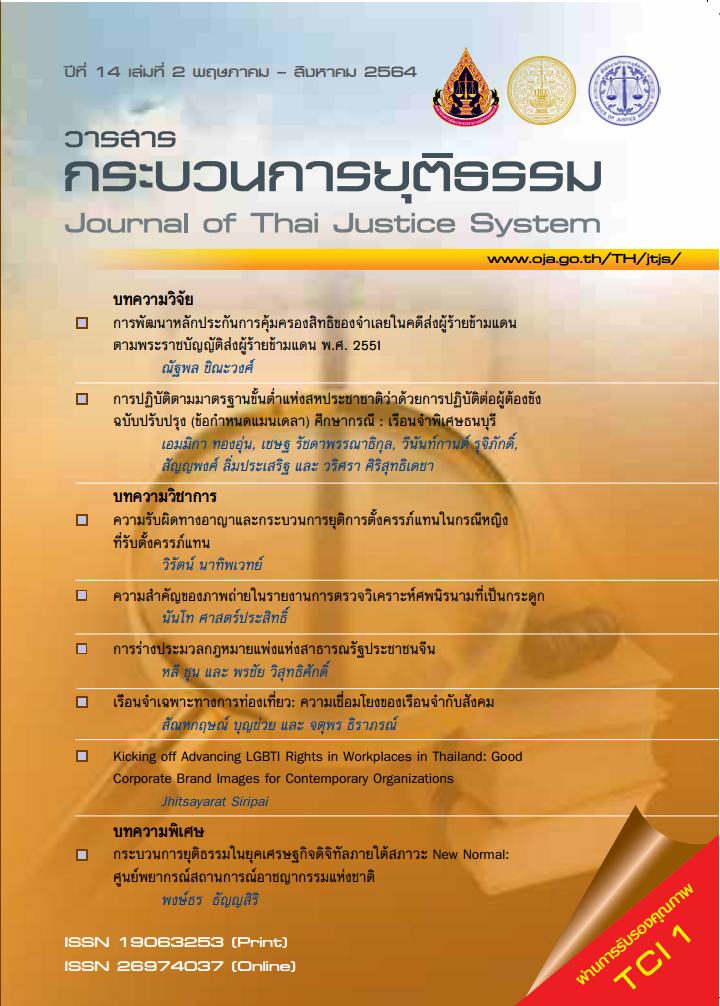เรือนจำเฉพาะทางการท่องเที่ยว: ความเชื่อมโยงของเรือนจำกับสังคม
Main Article Content
บทคัดย่อ
บทความนี้ต้องการนำเสนออีกหนึ่งมุมมองของภารกิจงานราชทัณฑ์ในปัจจุบันในการบริหารงานเรือนจำตามนโยบายผู้บริหารกระทรวงยุติธรรม เพื่อต้องการจำแนกผู้ต้องขังและพัฒนาศักยภาพในการฝึกอบรมได้ตรงเป้าหมาย และการแก้ไขฟื้นฟูพัฒนาพฤตินิสัยเพื่อส่งคืนผู้ต้องขังที่ได้รับโทษตามสมควรแล้วกลับคืนสู่สังคม จนกระทั่งได้จัดให้มีการสร้างเรือนจำเฉพาะทางในด้านต่าง ๆ ขึ้น ผู้เขียนได้เลือกกรณีตัวอย่างเรือนจำชั่วคราว ห้วยเตย จังหวัดหนองบัวลำภู เพราะได้มีโอกาสไปลงพื้นที่ภาคสนาม พบว่า ได้พัฒนาพื้นที่เรือนจำให้เป็นแหล่งท่องเที่ยวที่ดำเนินการสอดคล้องกับนโยบายของรัฐมนตรีว่าการกระทรวงยุติธรรม ในการส่งเสริมและพัฒนาเรือนจำให้เป็นแหล่งท่องเที่ยว เนื่องจากสภาพพื้นที่ของเรือนจำตั้งอยู่บนพื้นที่ที่มีภูมิทัศน์สวยงาม และเป็นเส้นทางผ่านของนักท่องเที่ยวที่เหมาะสมแก่การพักผ่อนหย่อนใจ นอกจากนี้ ยังได้พัฒนาให้เรือนจำชั่วคราวแห่งนี้เป็นเรือนจำด้านการเกษตรเพื่อที่จะพัฒนาทักษะผู้ต้องขังให้มีองค์ความรู้และฝึกวิชาชีพด้านการเกษตร ด้านการเลี้ยงสัตว์ และด้านการให้บริการการท่องเที่ยวแบบบูรณาการ โดยมุ่งหวังว่าจะเป็นประโยชน์สำหรับผู้ต้องขังในการนำไปประกอบสัมมาชีพในอนาคตภายหลังการพ้นโทษไปแล้ว และไม่หวนกลับมากระทำผิดซ้ำอีก ถือเป็นการย้ำชัดถึงการดำเนินนโยบายภารกิจการคืนคนดีสู่สังคมได้ทำให้เกิดขึ้นอย่างเป็นรูปธรรมและเกิดประสิทธิภาพต่อตัวผู้ต้องขังได้อย่างแท้จริง
Article Details

อนุญาตภายใต้เงื่อนไข Creative Commons Attribution-NonCommercial-NoDerivatives 4.0 International License.
ต้นฉบับที่ได้รับการตีพิมพ์ในวารสาร เป็นลิขสิทธิ์ของวารสารกระบวนการยุติธรรม แต่ความคิดเห็นที่ปรากฏในเนื้อหาของบทความในวารสารกระบวนการยุติธรรม ถือเป็นความรับผิดชอบของผู้เขียนแต่เพียงผู้เดียว
เอกสารอ้างอิง
กรมราชทัณฑ์. (2562). นโยบายนายสมศักดิ์ เทพสุทิน รัฐมนตรีว่าการกระทรวงยุติธรรม ในวาระการตรวจเยี่ยม และมอบนโยบายการทำงานของกรมราชทัณฑ์. นนทบุรี: กรมราชทัณฑ์.
กรมราชทัณฑ์. (2563). แนวนโยบายในการปฏิบัติงานของอธิบดีกรมราชทัณฑ์. วารสารราชทัณฑ์, 68(3), 10-12.
กรมราชทัณฑ์. (2564). สถิติผู้ต้องราชทัณฑ์ทั่วประเทศ สำรวจเมื่อวันที่ 1 มกราคม 2564. ค้นเมื่อ 6 กุมภาพันธ์ 2564, จาก http://www.correct.go.th/rt103pdf/report_result.php?date =2021-02-01&report=
พรชัย ขันตี และคนอื่นๆ. (2558). ทฤษฎีอาชญาวิทยา : หลักการ งานวิจัย และนโยบายประยุกต์. กรุงเทพฯ: มหาวิทยาลัยรังสิต.
พิศมัย จารุจิตติพันธ์ และจรัสสา การเกษตร. (2562). ความสูญเสียทางเศรษฐกิจของสังคมอันเนื่องจากการต้องขัง. วารสารวิชาการคณะบริหารธุรกิจ, 4(2), 195-209.
สถาบันเพื่อการยุติธรรมแห่งประเทศไทย. (2563). ผลสำรวจคดี “บอส อยู่วิทยา” ประชาชน เชื่อ “มีอำนาจอื่น แทรกแซงกระบวนการยุติธรรม” แต่มีเพียงร้อยละ 25 เชื่อว่าจะ “ปฏิรูปได้”. ค้นเมื่อ 7 มกราคม 2563, จาก https://www.tijthailand.org/th/highlight/detail/tij-poll-case-saravoot-yoovidhya
สยามรัฐ. (2563). เปิดโครงการกิจกรรมส่งเสริมอาชีพผู้ต้องขังเรือนจำชั่วคราวบ้านห้วยเตย. ค้นเมื่อ 10 กุมภาพันธ์ 2564, จาก https://siamrath.co.th/n/125508
แอนดรูว์ คอล์ย. (2552). การบริหารงานเรือนจำตามแนวทางสิทธิมนุษยชน คู่มือปฏิบัติงานของเจ้าหน้าที่เรือนจำ. นนทบุรี: กรมราชทัณฑ์.
Coyle, A. (2009). A human rights approach to prison management (2nd ed). London: International Centre for Prison Studies.
Siegel, J. L. (2014). Criminology: The core (4th ed). Stamford: Cengage Learning.


